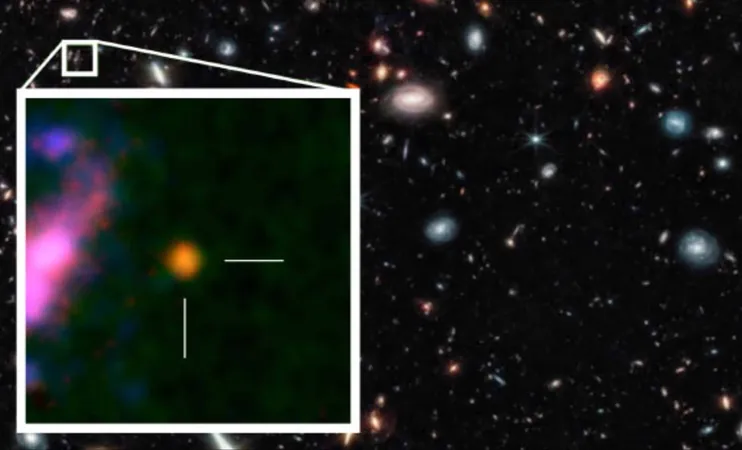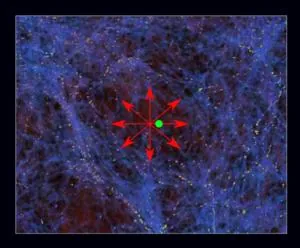
Astounding Discovery: Oxygen Found in the Most Distant Galaxy Ever!
2025-05-16
Author: Benjamin
A Cosmic Milestone: Oxygen's Journey Through Time
In an unprecedented find, scientists have detected oxygen in a galaxy so far away that its light has traveled an astonishing 13.4 billion years to reach Earth. This remarkable breakthrough, recently highlighted in a study published in Nature Astronomy, unveils insights into the universe's early stages, occurring just a few hundred million years after the Big Bang.
How ALMA and JWST Unraveled the Secrets of GHZ2
This groundbreaking detection was made possible by the sophisticated capabilities of two premier observatories: the Atacama Large Millimeter/submillimeter Array (ALMA) and the James Webb Space Telescope (JWST). Researcher Jorge Zavala shared the challenges faced during this observational feat, pointing out that the telescopes were aimed at a portion of the sky that would appear utterly empty to the naked eye. "We utilized the combined prowess of over forty antennas from ALMA and the 6.5-meter JWST for hours to uncover this hidden cosmic treasure," he stated. Their collaborative efforts allowed scientists to capture faint emissions from excited atoms, such as oxygen and hydrogen, unveiling the galaxy's elemental makeup and robust star formation activities.
GHZ2: A Cosmic Enigma of Star Formation
GHZ2, a compact galaxy with a mass equivalent to a few hundred million suns, is packed tightly within just a few hundred light-years. This incredible density mirrors the conditions of modern star clusters, raising intriguing questions about the formation of such structures shortly after the Big Bang. What's more, GHZ2's metallicity, or the concentration of elements heavier than hydrogen and helium, is merely one-tenth of what is found near our Sun, suggesting it exists in a still-young cosmic environment. Oxygen and other metals produced by short-lived, hot stars ionize the surrounding gas, with GHZ2 showcasing a rapid cycle of star formation that starkly contrasts with the slower rates seen in more evolved galaxies. This vibrant activity might illuminate how certain galaxies amassed substantial mass in the universe's early chapters.
Unlocking Mysteries of Globular Clusters and Galactic Evolution
The intriguing characteristics of GHZ2 could provide vital insights into the formation of globular clusters—ancient, densely packed groups of stars found in galaxies like our own Milky Way. Researchers have identified similarities in elemental compositions and stellar density between GHZ2 and these long-lived clusters. Understanding whether galaxies like GHZ2 may have acted as the foundational seeds for globular clusters could solve a longstanding puzzle in astrophysics. Tom Bakx from Chalmers University remarked on the significance of this discovery, stating, "This study marks a pinnacle in our multi-year quest to unravel the enigma of early galaxies." He emphasized that further telescope investigations will be pivotal in uncovering the intricacies of metal evolution, star formation, and black holes during the universe's formative years. Future studies promise to delve deeper into GHZ2's structure and chemical composition, unlocking more secrets about the formative epochs of our cosmos.









 Brasil (PT)
Brasil (PT)
 Canada (EN)
Canada (EN)
 Chile (ES)
Chile (ES)
 Česko (CS)
Česko (CS)
 대한민국 (KO)
대한민국 (KO)
 España (ES)
España (ES)
 France (FR)
France (FR)
 Hong Kong (EN)
Hong Kong (EN)
 Italia (IT)
Italia (IT)
 日本 (JA)
日本 (JA)
 Magyarország (HU)
Magyarország (HU)
 Norge (NO)
Norge (NO)
 Polska (PL)
Polska (PL)
 Schweiz (DE)
Schweiz (DE)
 Singapore (EN)
Singapore (EN)
 Sverige (SV)
Sverige (SV)
 Suomi (FI)
Suomi (FI)
 Türkiye (TR)
Türkiye (TR)
 الإمارات العربية المتحدة (AR)
الإمارات العربية المتحدة (AR)